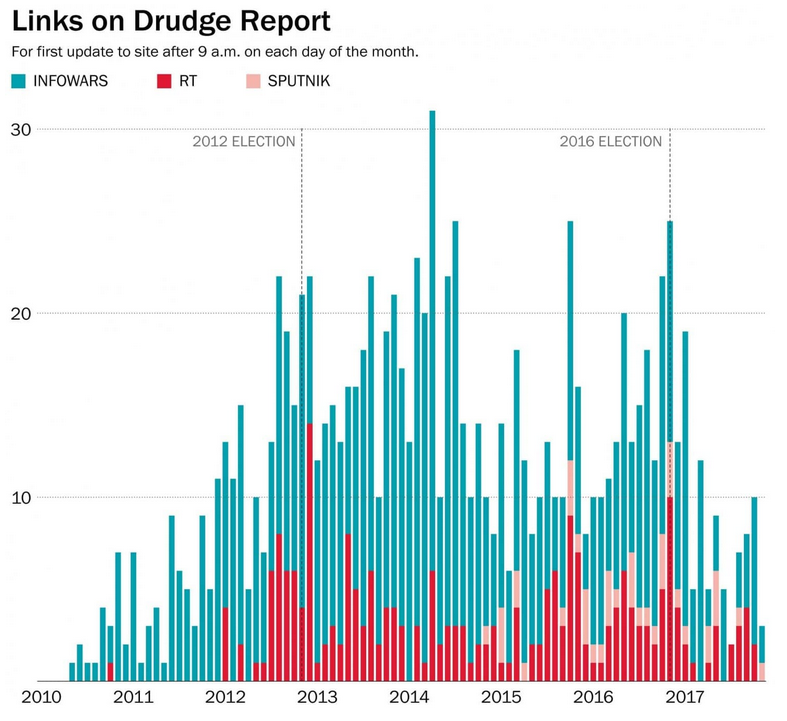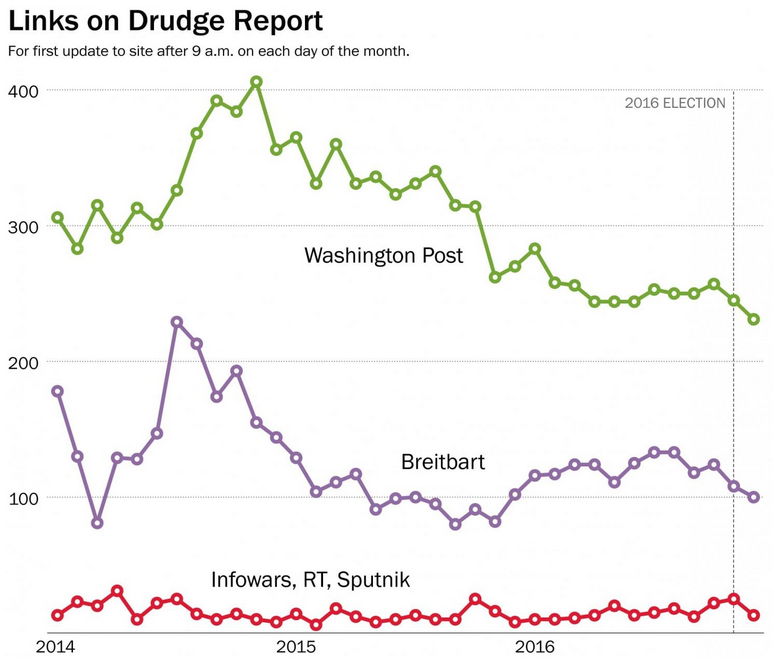By July 2016, according to the analysis site SimilarWeb, Matt Drudge’s link-aggregation site Drudge Report was the second-most-visited on the Internet in the United States. Over the course of the month — the month of the Republican and Democratic presidential conventions and the month of the leak of emails stolen from the Democratic National Committee — SimilarWeb estimates that Drudge had 1,472,220,000 page views. That’s 1.4 billion, the equivalent of 47 views of the Drudge Report every second of every minute that month.
Being the second-most-visited site, incidentally, means that Drudge had more page views than Yahoo, Disney (including ABC and ESPN) and Time Warner. It had more than the New York Times and The Washington Post, combined — with enough space left over to also outpace Hearst.
By December, Drudge had fallen to third, the position it had held for most of 2016. That month, though, the number of page views had climbed to 1.83 billion. That’s as though 58 people loaded Drudge Report every second that month.
Translated into universally accessible terms, the Drudge Report was a traffic behemoth during the 2016 election. And every time the page was loaded last year (and today, should you visit), there were two direct links to the conspiracy-theory-hawking site Infowars.
To be fair, those two links were included in the long list of links to news websites and pundits at the bottom of the Drudge homepage. But over the course of the campaign, Drudge was also not shy about linking directly to individual stories at Infowars, as well as RT and Sputnik News, both content-sharing arms of the Russian government.
DrudgeReportArchives captures an image of the Drudge Report every two minutes, as it has for 16 years. We ran a script that checked the first update to Drudge Report after 9 a.m. on every day of the past decade, counting the number of times Drudge linked to Infowars, RT or Sputnik. Over that period, excluding the two standing links to Infowars, we tallied more than 1,000 links to those sites.
Drudge started linking to Infowars in 2010. His first link to RT was that same year. Sputnik News wasn’t created until November 2014; Drudge’s first link to that site came later that month.
- Infowars: “Racist film ‘Machete’ produced with taxpayer funds”
- RT: “Coldest winter in 1,000 years on its way”
- Sputnik: “European Nations Repatriate Gold Reserves From United States Vaults”
On two days, we found four links to the three sites on the Drudge homepage.
One was on March 3, 2015, when Drudge linked to articles about how supporters of Barack Obama endorsed Karl Marx for president (Infowars), emails sent from Sidney Blumenthal to Hillary Clinton (RT), about crime in Texas (Sputnik) and how the United States was sending the National Guard to Ukraine (Sputnik).
The other day was Oct. 6, 2015. The four articles that day: Activists using drones to spy on an NSA facility (Sputnik), how the Islamic State might be sneaking across the Mexico border (Infowars), support for a “white privilege” tax by Clinton supporters (Infowars) and a rumor that a mass shooter in Oregon was taking psychoactive drugs (Infowars).
There are probably two reasons that the Drudge Report linked to these sites with regularity. The first is that Drudge’s taste in news often tends toward the more exotic; he clearly understands the sorts of things that people like to read. The other is that Drudge himself seems to share some of the same sense of impending apocalypse and systemic collapse that undergirds a lot of the reports from these sites.
On more than a third of the days between when Donald Trump announced his candidacy and when he won the presidency, the Drudge Report had a link from Infowars, RT or Sputnik on its homepage by 9 a.m. The month in which there were the most links to the three sites was April 2014. The second-most links in a month was a three-way tie — including November 2016. There were no links to the sites on the morning of the election, but on Nov. 7, there were three: A story about protesters crashing a Clinton rally (Infowars), a story about WikiLeaks suffering a denial-of-service attack (RT) and a story about a German town building a wall to separate out refugees (RT).
It’s important to contextualize this. From 2014 to 2016, links to Infowars, RT and Sputnik were only a small part of the links on the site. There were far more links to The Post, for example — and to Breitbart.
That said, there’s no question that the three sites saw a lot of traffic that was driven by Drudge. In October, the month before the 2016 election, SimilarWeb announced that one particular site was rising on the charts, with a bullet.
“Last but not least,” the site’s Orit Coty wrote, “infowars.com, known for its acclaimed host and conspiracy theorist, Alex Jones, made an extraordinary leap of 31 spots advancing to 84th in October’s ranking.” That month, Infowars had 57.8 million pageviews, more than the BBC, Wired . . . or RT, which had climbed to 95th, up from 108th.



